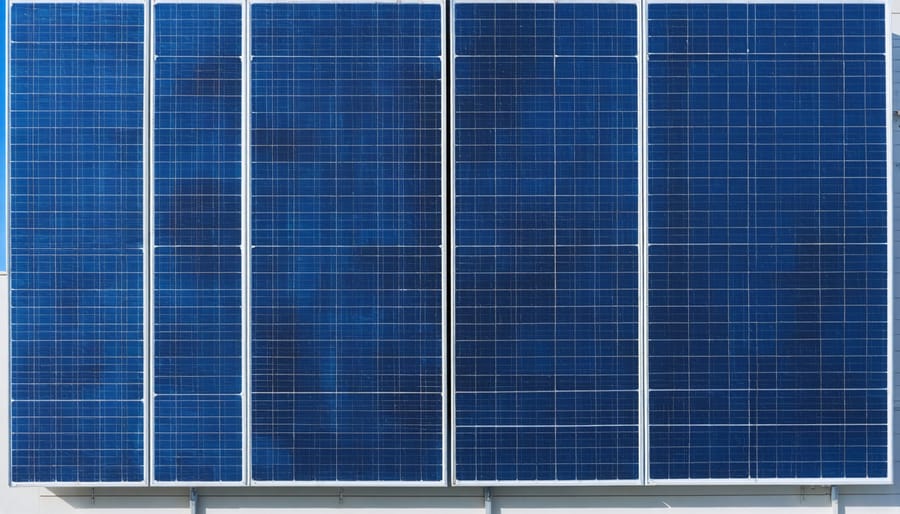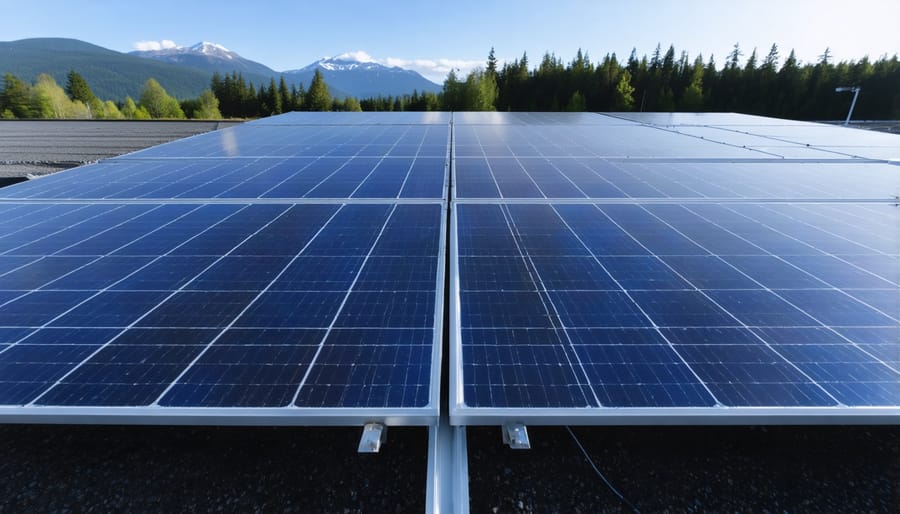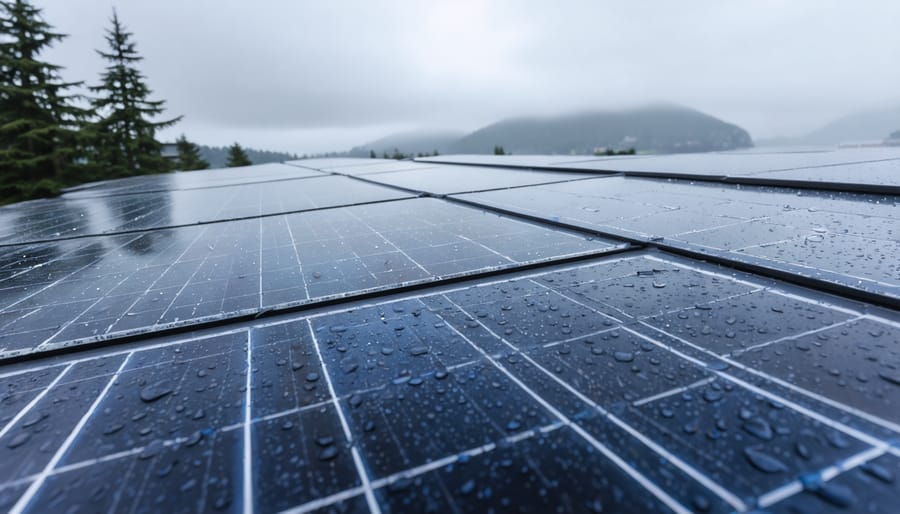Solar panel technology has transformed dramatically in 2024, with innovations delivering up to 47% more energy than panels installed just five years ago. For British Columbia homeowners and businesses, these breakthroughs mean capturing more power during our cloudy winters and maximizing output during long summer days—addressing the biggest concern about solar viability in our climate.
Perovskite-silicon tandem cells now achieve 33% efficiency in commercial applications, nearly double the performance of conventional panels. Bifacial modules capture reflected light from snow and water, boosting annual energy production by 20-30% in BC’s unique environment. Meanwhile, building-integrated photovoltaics (BIPV) are eliminating the aesthetic concerns that once stopped many Vancouver and Victoria property owners from going solar.
These technologies aren’t laboratory concepts—they’re available now through BC installers, with early adopters in Kelowna and Nanaimo already seeing dramatic reductions in their electricity bills. The timing proves particularly compelling as BC Hydro rates continue climbing and provincial incentives make upgrades more affordable than ever. Understanding which innovations match your property’s specific conditions—whether you’re in the rainy Lower Mainland or sunny Okanagan—determines whether you’ll achieve meaningful energy independence or underwhelming returns on your investment.
Why Traditional Solar Panels Struggle in BC Weather
British Columbia’s weather presents unique challenges for solar energy adoption. With an average of 160 rainy days per year in coastal regions and significant cloud cover during fall and winter months, many homeowners and businesses have hesitated to invest in solar technology. The concern is understandable—traditional solar panels were designed with sunny climates in mind and performed best under direct, intense sunlight.
Older photovoltaic technology struggled with efficiency during BC’s grey winter days when sunlight is both limited and diffused through cloud cover. Between November and February, some areas receive as little as eight hours of daylight, and much of that comes filtered through overcast skies. Traditional panels could lose 40-60% of their generating capacity on cloudy days, making the return on investment seem questionable for BC residents.
Rain, while not directly damaging to panels, often accompanies the persistent cloud systems that reduce solar generation for weeks at a time. These extended periods of low production meant that early adopters sometimes faced disappointing energy bills, reinforcing the perception that solar “just doesn’t work here.”
This reputation has lingered even as technology improved, creating a knowledge gap about what’s possible today. Many British Columbians still assume solar panels need desert-like conditions to be viable, unaware that newer innovations have fundamentally changed how panels capture and convert even indirect sunlight into usable energy.
Bifacial Solar Panels: Capturing Light From Every Angle

Real Results: A Vancouver Island Success Story
When Duncan-based Good Earth Coffee Roasters installed bifacial solar panels on their warehouse rooftop in 2023, they weren’t sure what to expect from Vancouver Island’s cloudy reputation. The results exceeded their projections.
“We’re producing 28% more energy than we would with traditional panels,” explains owner Tom Henderson. “The bifacial design captures reflected light from our white rooftop membrane, which makes a huge difference even on overcast days.”
The 50-panel system generates approximately 18,500 kWh annually—enough to power their entire roasting operation during daylight hours. This translates to $2,400 in annual savings on their electricity bills, with the system expected to pay for itself in just under nine years.
What surprised Henderson most was the winter performance. “January and February were actually impressive. While production drops compared to summer, the panels still generate meaningful power thanks to BC’s relatively mild coastal climate and snow reflection during our occasional winter storms.”
The coffee roaster now proudly displays their real-time energy production on a monitor visible to café customers, turning their solar investment into a community conversation starter about sustainable business practices.
Perovskite Solar Cells: The Low-Light Champions
Perovskite solar cells represent one of the most exciting developments in renewable energy, offering BC homeowners a glimpse into the future of solar technology. Named after the crystal structure they’re made from, these innovative panels excel where traditional silicon cells struggle—specifically in cloudy, overcast, and low-light conditions that are common throughout much of British Columbia’s fall and winter months.
What makes perovskites remarkable is their ability to capture a broader spectrum of light, including diffuse sunlight that filters through clouds. In laboratory settings, they’ve achieved efficiency rates comparable to established solar manufacturers, while potentially costing less to produce. For BC residents who’ve hesitated about solar due to our region’s reputation for grey skies, this technology could be transformative.
Currently, perovskite panels aren’t widely available for residential installation. They’re still in the final stages of development, with researchers working to extend their lifespan and durability to match traditional silicon panels’ 25-year warranties. However, several manufacturers expect to bring commercial products to market within the next two to five years.
What should BC residents watch for? Look for hybrid panels that combine perovskite with traditional silicon—these “tandem cells” are likely to arrive first, offering improved performance in our variable climate. Keep an eye on Canadian pilot projects and demonstrations, as local testing in BC’s specific weather conditions will provide valuable real-world data.
While you wait, connecting with local solar installers now helps you stay informed about when these panels become available. Early adopters of this technology could see significant performance improvements, particularly in coastal regions where cloud cover is most persistent throughout the year.
PERC and TOPCon Technology: More Power From Less Sun

How Much More Energy Can You Actually Generate?
Standard solar panels typically convert 15-17% of sunlight into electricity, while PERC technology pushes this to 20-22%, and the newest TOPCon panels reach an impressive 24-25% efficiency. But what does this mean for your BC home or business?
In practical terms, a typical Vancouver household using standard 300-watt panels would need about 20 panels to meet their energy needs. With TOPCon technology, that same household could achieve identical output with just 16-17 panels, saving valuable roof space and reducing installation costs.
BC’s often-cloudy conditions make this efficiency gain particularly valuable. During our darker winter months, PERC and TOPCon panels generate 12-18% more energy than standard panels under the same low-light conditions. For a medium-sized commercial installation in Victoria, this translates to an additional 1,500-2,000 kWh annually—enough to power several office computers year-round.
A Kelowna family who upgraded from standard to PERC panels reported their system now produces enough excess energy during summer to offset 90% of their winter electricity costs, compared to 70% with their previous setup.
Smart Solar Panels With Built-In Optimization
Traditional solar installations treat panels as a single unit, which means one shaded panel can drag down your entire system’s performance. Smart solar panels with built-in optimization technology solve this challenge by allowing each panel to operate independently at its maximum potential.
These innovative panels come equipped with integrated microinverters or power optimizers mounted directly on each module. Unlike conventional systems where shade on one panel affects all connected panels, smart panels ensure that only the shaded unit experiences reduced output while the rest continue generating at full capacity.
For BC homeowners, this technology is particularly valuable. Consider Vancouver’s leafy neighborhoods where mature trees cast moving shadows throughout the day, or properties in Victoria where neighboring buildings create partial shade during morning or evening hours. With standard panels, these common scenarios can reduce system output by 25-40%. Smart panels minimize these losses dramatically, often maintaining 85-95% of total system capacity even with partial shading.
The Thompsons, a family in Burnaby, saw this firsthand. Their roof faces southeast with afternoon shade from a tall cedar tree. After installing smart solar panels with integrated optimizers, their system generates 32% more power annually compared to what conventional panels would have produced in the same location.
Beyond shading benefits, smart panels provide real-time monitoring for each individual unit. You’ll receive alerts if a specific panel needs cleaning or maintenance, preventing small issues from becoming costly problems. This panel-level insight also helps installers optimize initial placement and troubleshoot performance concerns quickly.
While smart solar panels typically cost 10-15% more upfront than conventional systems, the increased energy production and reduced maintenance needs often result in shorter payback periods, especially for properties with any shading challenges.
Half-Cut Cell Technology: Better Performance in Real-World Conditions
Half-cut cell technology represents a straightforward yet powerful innovation in solar panel design. Instead of using full-sized cells, manufacturers cut standard solar cells in half, effectively doubling the number of cells in each panel while reducing the electrical current flowing through them.
This seemingly simple change delivers impressive real-world benefits, particularly for British Columbia’s often cloudy and variable weather conditions. When shade falls across a traditional solar panel, it can significantly reduce the entire panel’s output. Half-cut cells minimize this impact because each half operates more independently. If one section experiences shade while another receives sunlight, the illuminated portion continues generating power efficiently.
The reduced current in half-cut cells also means less resistive energy loss, which translates to better performance during BC’s cooler months and improved heat tolerance during summer sunshine. Many BC homeowners notice the difference on those partly cloudy days—common throughout our region—when half-cut panels maintain steadier output compared to conventional designs.
A Vancouver Island family recently upgraded to half-cut cell panels and reported 8% higher energy production compared to their previous system, despite having trees shading their roof during morning hours. Their installer noted that half-cut technology made installation viable where conventional panels would have underperformed.
While half-cut panels typically cost 5-10% more than standard panels, the improved performance often justifies the investment, especially for installations facing shading challenges or mixed-light conditions common in BC’s coastal and forested areas.
What These Technologies Actually Cost in BC
Let’s talk real numbers. In BC, traditional monocrystalline panels typically cost between $2.50 to $3.50 per watt installed, while the newest technologies command a premium. Bifacial panels run about 10-15% higher, perovskite-silicon tandems add roughly 20-25% to your upfront investment, and TOPCon technology sits somewhere in between at 8-12% above proven panel technology pricing.
For a typical BC home requiring a 7kW system, you’re looking at $17,500-$24,500 for conventional panels versus $19,250-$30,625 for cutting-edge options. The difference? These newer technologies generate 15-30% more electricity from the same roof space, particularly valuable given BC’s variable weather conditions.
Here’s where it gets interesting for your wallet. BC Hydro’s Net Metering Program credits you for excess power at retail rates, currently around $0.12-$0.14 per kWh. The CleanBC Better Homes rebate offers up to $5,000 for solar installations when combined with energy efficiency upgrades, while the federal Greener Homes Grant provides an additional $5,000.
A Vancouver homeowner who installed bifacial panels last year shared that with available incentives, their effective cost dropped from $28,000 to $18,000. Their enhanced generation means they’re seeing payback in 9-11 years versus 12-15 years with standard panels—and that’s with BC’s relatively low electricity rates.
For commercial installations, the Canada Small Business Financing Program can help finance up to $1 million, and businesses benefit from accelerated capital cost allowances.
The honest assessment? If you have limited roof space, challenging conditions like partial shade, or plan to stay in your property long-term, the premium for newer technology makes financial sense. If you’re maximizing a large, unobstructed south-facing roof, traditional panels might deliver better value. Our solar savings calculator can help you model both scenarios with your specific electricity usage and roof characteristics.
Choosing the Right Technology for Your BC Property
Selecting the right solar technology for your BC property depends on understanding your unique location and energy needs. Let’s break down the key factors that will guide your decision.
**Location Matters**
Coastal properties face salt air and frequent rain, making bifacial panels with corrosion-resistant frames an excellent choice. These panels capture reflected light from both sides, maximizing output even on overcast days. Interior locations experience more temperature extremes, where industry-leading solar panels with high-temperature coefficients maintain efficiency during hot summers and cold winters.
**Residential vs. Commercial Considerations**
Homeowners with limited roof space benefit most from high-efficiency monocrystalline panels, squeezing maximum power from every square meter. Commercial buildings with expansive roofs can consider cost-effective polycrystalline options or innovative building-integrated photovoltaic (BIPV) systems that replace traditional roofing materials entirely.
**Roof Orientation and Weather Patterns**
East or west-facing roofs previously considered less ideal now perform remarkably well with bifacial technology. North-facing installations remain challenging but aren’t impossible with the newest high-efficiency options. Properties in the Okanagan’s sunnier climate can prioritize cost per watt, while coastal communities should invest in panels proven to perform under low-light conditions.
**Your Decision Framework**
Start by assessing your annual energy consumption, available installation space, and budget. Consider your timeline—are you planning to stay long-term or might you relocate? Next, get quotes comparing different technologies specific to your situation. Request production estimates based on your actual roof orientation and local weather data.
Many BC solar installers now offer free site assessments using satellite imagery and shade analysis tools, providing accurate projections before you commit to any technology.

Modern solar panel technology has decisively overcome British Columbia’s unique climate challenges. From bifacial panels that capture reflected light on cloudy days to advanced coatings that maintain performance during our rainy seasons, today’s innovations make solar energy a practical reality throughout the province—not just in sunny locations. Whether you’re in Vancouver, Prince George, or the Kootenays, these technological breakthroughs mean you can now harness the sun’s power efficiently year-round.
The next step is yours to take. Solar BC offers user-friendly calculation tools that show your potential energy savings based on your specific location and roof characteristics. Within minutes, you’ll see real numbers that demonstrate how these newest technologies can work for your home or business. Once you’ve explored your options, connecting with Solar BC’s network of certified local installers ensures you receive a professional site assessment tailored to your property’s unique conditions. These experts understand BC’s building codes, weather patterns, and available incentives, guiding you from initial curiosity to a fully functioning solar system. The technology is ready—and so is the support you need to make an informed decision.

